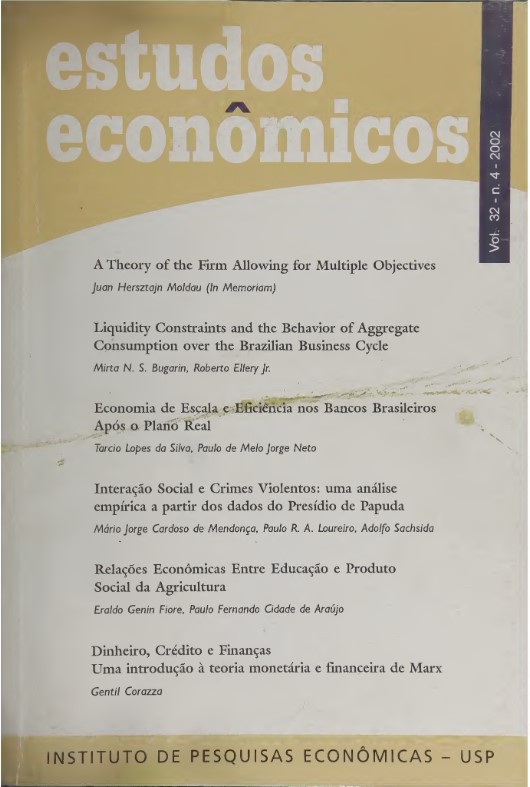Interação social e crimes violentos: uma análise empírica a partir dos dados do presídio de Papuda
Palavras-chave:
Interação social, Criminalidade, Viés de seleção de amostraResumo
Este artigo baseia-se no modelo teórico desenvolvido por Becker (1968), que mostra a relação entre interação social e comportamento ilegal. Fazendo uso de dados obtidos no presidio da Papuda, no Distrito Federal, foram estimadas relações de comportamento que mostram que variáveis de interação social, tais como bom relacionamento familiar, tem impacto negativo sobre a criminalidade. Alem disso, foi utilizado urn modelo de vies de seleção de amostra (HECKMAN, 1979) que permite estimar uma função de comportamento. Com este modelo foi possível mostrar que existe diferença na regra otima de escolha que determina o modus operandi entre os agentes que cometem crimes violentos e os que cometem crimes não violentos.
Downloads
Referências
BECKER, G. Crime and punishment: an economic approach. Journal of Political Economy, v. 101, p. 169-217, 1968.
BECKER, Gary S. A theory of social interactions. Journal of Political Economy, v. 82, n. 6, p. 1063-93, 1974.
BECKER, G.; TOMES, N. An equilibrium theory of the distribution of income an intergenerational mobility.Journal ofPolitical Economy, v. 87, p. 1163-1189, 1979.
BLUMSTEIN, A. Touth violence, guns and the illicit-drug industry. The Journal of Criminal Law and Criminology, v. 86, n. 4, p. 1175-1216, 1995.
BLUMSTEIN, A.; ROSENFELD, R. Explaining recent trens in U. S. homicide rates. The Journal ofCriminal Law and Criminology, v. 86, n. 1, p. 10-36, 1998.
EHRLICH, I. Participation in illegitimate activities: a theorical and empirical investigation. Journal ofPolitical Economy, v. 81, p. 521- 565, 1973.
EHRLICH, I. Deterrent effect of capital punishment: a question of life and death. American Economic Review, p. 397-417, December 1975.
FAJNZYLBER, P.; LEDERMAN, D.; LOAYZA, N. What causes violent crime. World Bank Report, 1998.
FLEISCHER, B. M. The effect of income on delinquency. American Economic Review, v. 56, p. 118-137, 1966.
FREEMAN, R. B. The economics of crime. In: ASHENFELTER, O.; CARD, D. (eds.),Handbook of labor economics. Elsevier Science, 1999, v. 3.
FREEMAN, R. B.; RODGERS El, W M. Area economic conditions and the labor market outcomes of young men in the 1990s expansion. NBER Working Paper 7073, April 1999.
GLAESER, E. L.; SACERDOTE, B.; SCHEINKMAN, J. A. Crime and social interactions. Quarterly Journal of Economics, v. Ill, p. 507-548, 1996.
GOLDBERGER, Arthur S. A course in econometrics. Cambridge, Massachusetts: Havard University Press, December 1991.
GREENE, W Econometric analysis. Prentice Hall, 1993.
GROGGER, Jeffrey. Local violence and educational attainment. The Journal of Human Resources, Madison, v. 32, Issue 4, p. 659-682, Fall 1997.
HECKMAN, J. Sample selection bias as a specification error. Econometrica, v. 47, n. 1, p. 153-161, 1979.
HECKMAN, J. The common structure ofstatistical models oftruncation, sample selection, and limited dependent variables and a simple estimator for such models. Annuals of Economic and Social Measurement, 5, p. 475-92, 1976.
IMAI, Susumu; KRISHNA, Kala. Employment, dynamic deterrence and crime. NBER Working Paper n. w8281. Disponível em: http://papers.nber.org/papers/W8281. Issued in May 2001.
JUDGE, George G.; HILL, R. Carter; GRIFFITHS, William E.;
LUTKEPOHL, Helmut; LEE, Tsoung-Chao.Introduction to the theory and practice of econometrics. John Wiley & Sons, Inc. 1982.
LEVITT, S. D. The effect ofprison population size on crime rates: evidence from prison overcrowding; litigation. Quarterly Journal of Economics, v. Ill, p. 320-351, 1996.
LEVITT, S. D.; LOCHNER, Lance. The determinants ofjuvenile crime. NBER Wirking Paper Disponível em: http://www.nber.org/books/gruber/juvenilecrime.pdf. University of Rochester, p. 1-58, February 2000.
LOCHNER, L. A theoretical and empirical study ofindividual perceptions of the criminal justice system. Working Paper n. 483, June 2001. Disponível em: http;//ideas.uqam.ca/ideas/data/Papers/rocrocher483.html University of Rochester, p. 1-53.
SAH, R. Social osmosis and patterns of crime. Journal of Political Economy, v. 99, p. 1272-1295, 1991.
STATA. Stata User^s Guide, Realease 6. College Station, Texas: Stata Press WILLIS, R.; ROSEN, S. Education and self-selecxion.Journal of Political Economy, v. 87, S1-S36, 1979.
WITTE, Ann Dryden; WITT, Robert. What we spend and what we get: public and private provision of crime prevention and criminal justice. NBER Working Paper n. w8204. Issued in April 2001. Disponível em: http://papers.nber.org/papers/W8204, p. 1-50.
Downloads
Publicado
Edição
Seção
Licença
Copyright (c) 2002 Mário Jorge Cardoso de Mendonça, Paulo R. A. Loureiro, Adolfo Sachsida

Este trabalho está licenciado sob uma licença Creative Commons Attribution-NonCommercial 4.0 International License.
A submissão de artigo autoriza sua publicação e implica o compromisso de que o mesmo material não esteja sendo submetido a outro periódico.
A revista não paga direitos autorais aos autores dos artigos publicados.
O detentor dos direitos autorais da revista é o Departamento de Economia da Faculdade de Economia, Administração, Contabilidade e Atuária da Universidade de São Paulo.




